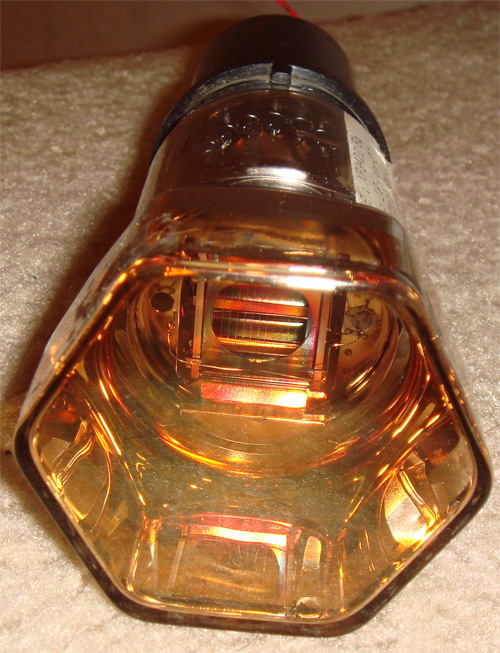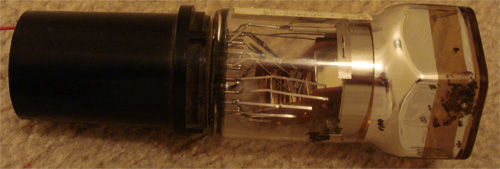Just a shoutout to my hacker buds in Kansas City — they have opened a hacker space and their open house is on March 2nd. Congrats! Read more about it at the Cowtown Computer Congress blog and their press release! It sounds like a cool space, it’s in a cave 85 feet below ground level. Speaking of shanzhai…
Tech Trend: Shanzhai
February 26th, 2009The shanzhai of China are a tech trend to keep an eye on. Typically dismissed by popular press as simply the “copycat barons from China”, I think they may have something in common with Hewlett and Packard or Jobs and Wozniak back when they were working out of garages. I’ve heard quite a few stories about the shanzhai while on my most recent trip to China, some of which I will share here.
First, let’s try to understand the cultural context of the word shanzhai. Shanzhai (山寨) comes from the Chinese words “mountain fortress”. The literal translation is a bit misleading. The English term “fortress” connotes a fortified structure or stronghold that is large, perhaps conjuring imagery of castle turrets and moats. On the other hand, the denotation simply states that it is simply a fortified place. This latter denotation is closer to the original meaning from Chinese; in fact, the fortress they are referring to is closer to a cave or guerrilla-style hideout. In its contemporary context, shanzhai is a historical allusion to the legends that dwelled within. One such legend is the 12th-century story of the 108 bandits of Song Jiang. It is still a popular tale today; my father recognized it instantly when I asked him about it. A friend of mine described Song Jiang as a sort of Robin Hood meets Che Guevara; Song Jiang was a rebel and a soldier of fortune, yet selfless and kind to those in need.
The contemporary shanzhai are rebellious, individualistic, underground, and self-empowered innovators. They are rebellious in the sense that the shanzhai are celebrated for their copycat products; they are the producers of the notorious knock-offs of the iPhone and so forth. They individualistic in the sense that they have a visceral dislike for the large companies; many of the shanzhai themselves used to be employees of large companies (both US and Asian) who departed because they were frustrated at the inefficiency of their former employers. They are underground in the sense that once a shanzhai “goes legit” and starts doing business through traditional retail channels, they are no longer considered to be in the fraternity of the shanzai. They are self-empowered in the sense that they are universally tiny operations, bootstrapped on minimal capital, and they run with the attitude of “if you can do it, then I can as well”.
An estimate I heard places 300 shanzhai organizations operating in Shenzhen. These shanzai consist of shops ranging from just a couple folks to a few hundred employees; some just specialize in things like tooling, PCB design, PCB assembly, cell phone skinning, while others are a little bit broader in capability. The shanzai are efficient: one shop of under 250 employees churns out over 200,000 mobile phones per month with a high mix of products (runs as short as a few hundred units is possible); collectively an estimate I heard places shanzhai in the Shenzhen area producing around 20 million phones per month. That’s an economy approaching a billion dollars a month. Most of these phones sell into third-world and emerging markets: India, Africa, Russia, and southeast Asia; I imagine if this model were extended to the PC space the shanzhai would easily accomplish what the OLPC failed to do. Significantly, the shanzai are almost universally bootstrapped on minimal capital with almost no additional financing — I heard that typical startup costs are under a few hundred thousand for an operation that may eventually scale to over 50 million revenue per year within a couple years.
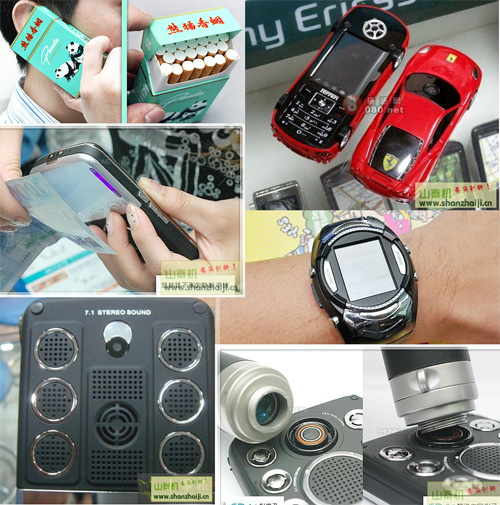
Significantly, they do not just produce copycat phones. They make original design phones as well, as documented in this PDF (it is in Chinese, but the pictures are cool; the collage above is ganked from the PDF). These original phones integrate wacky features like 7.1 stereo sound, dual SIM cards, a functional cigarette holder, a high-zoom lens, or a built-in UV LED for counterfeit money detection. Their ability to not just copy, but to innovate and riff off of designs is very significant. They are doing to hardware what the web did for rip/mix/burn or mashup compilations. The Ferrari toy car meets mobile phone, or the watch mixed with a phone (complete with camera!) are good examples of mashup: they are not a copies of any single idea but they mix IP from multiple sources to create a new heterogeneous composition, such that the original source material is still distinctly recognizable in the final product. Also, like many web mashups, the final result might seem nonsensical to a mass-market (like the Ferrari phone) but extremely relevant to a select long-tail market. Interestingly, the shanzhai employ a concept called the “open BOM” — they share their bill of materials and other design materials with each other, and they share any improvements made; these rules are policed by community word-of-mouth, to the extent that if someone is found cheating they are ostracized by the shanzhai ecosystem.
To give a flavor of how this is viewed in China, I heard a local comment about how great it was that the shanzhai could not only make an iPhone clone, they could improve it by giving the clone a user-replaceable battery. US law would come down on the side of this activity being illegal and infringing, but given the fecundity of mashup on the web, I can’t help but wonder out loud if mashup in hardware is all that bad. I feel there is definitely a bias in the US that “if it’s strange and it happens in China it must be bad”, which casts a long shadow over objective evaluation of new cultural phenomenon that could eventually be very relevant to the US.
In a sense, I feel like the shanzhai are brethren of the classic western notion of hacker-entrepreneurs, but with a distinctly Chinese twist to them. My personal favorite shanzhai story is of the chap who owns a house that I’m extraordinarily envious of. His house has three floors: on the top, is his bedroom; on the middle floor is a complete SMT manufacturing line; on the bottom floor is a retail outlet, selling the products produced a floor above and designed two floors above. How cool would it be to have your very own SMT line right in your home! It would certainly be a disruptive change to the way I innovate to own infrastructure like that — not only would I save on production costs, reduce my prototyping time, and turn inventory aggressively (thereby reducing inventory capital requirements), I would be able to cut out the 20-50% minimum retail margin typically required by US retailers, assuming my retail store is in a high-traffic urban location.
Those who read this blog have probably seen my posts about the markets in Shenzhen. I always had a theory that at some point, the amount of knowledge and the scale of the markets in the area would reach a critical mass where the Chinese would stop being simply workers or copiers, and would take control of their own destiny and become creators and ultimately innovation leaders. I think it has begun — these stories I’m hearing of the shanzhai and the mashup they produce are just the beginning of a hockey stick that has the potential to change the way business is done, perhaps not in the US, but certainly in that massive, untapped market often referred to as the “rest of the world”.
Mobile Phone Mega-Market in Shenzhen
February 24th, 2009One thing that’s true about the technology markets in China is that the more you learn about it, the less you find you know. Liam Casey, “Mr. China” himself, and the CEO of PCH, came in and said exactly that our first day on the tour. I had a first-hand experience with that while I was acting as a tour guide of the SEG market in Shenzhen. I knew that the SEG market was big, and that it had a lot of stuff, but somehow I managed to miss the massive mobile phone market for the two years that I had been shopping there. A friend of mine in PCH tipped me off to the market, so at the end of the walking tour of the main market that I was familiar with, we decided to head out and try to find something that none of us, including me had previously seen.
My eyes fell out of my head when I saw it.
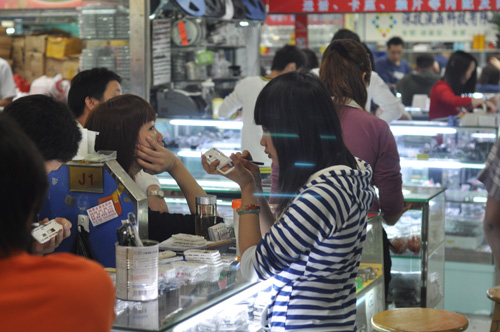
Imagine a market, the acreage of two gymnasiums, but four stories tall, packed with nothing but … mobile phone bits and pieces (and finished phones too). It’s impossible to find a single photo that communicates the sheer scale of this market — above is just a flavor of a tiny corner of the area. You hear numbers like 500 million phones being made in China per year, but you don’t actually get to feel it until you walk this market. There is literally everything in there to make phones, from blank PCBs, to intermediate assemblies, to shells, testing equipment, raw chips, batteries, LCDs, broken down parts, you name it.
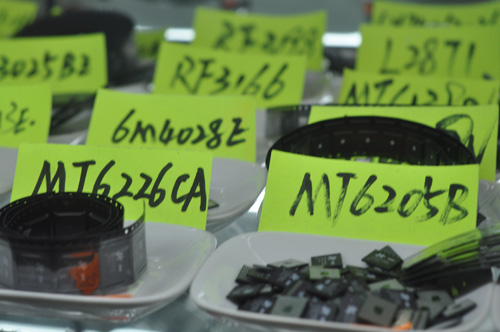
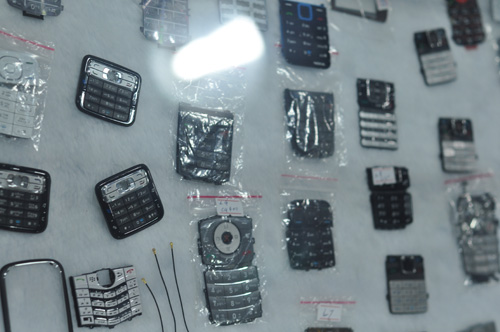
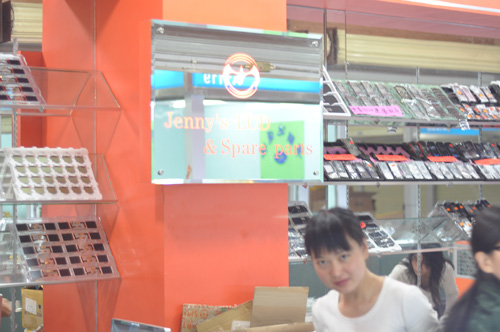
(The mirrored sign above reads: “Jenny’s LCD and Spare Parts”. I wish I could find a mall in the US with that very store in it. That would be so handy, at least for me).
And the most interesting part about the market is not that these components were for sale — it was the amount of actual (re)manufacturing being done right in the market. It was hard to walk more than twenty feet without seeing a booth crammed cheek to jowel with soldering irons, power supplies and people either disassembling or assembling phones. There’s a similar spot across from the main market that specializes in laptop remanufacturing, but the scale and throughput is much smaller than what I saw in the mobile phone market.
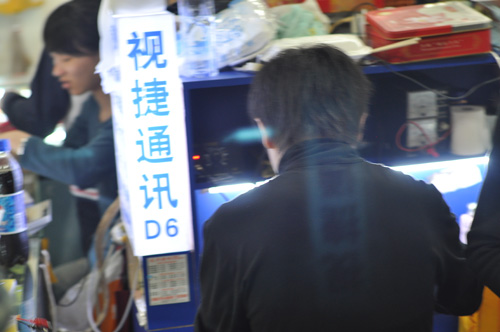
The other crazy thing about the mobile phone market is that it’s not the only one. Windell said he found another market just as big but with a greater focus on finished phones, and then just today I walked into what looked like the New York Stock Exchange of mobile phones. This last find was really fascinating; there is a spot in the heart of the market where you have chain smoking traders sitting in booths piled high with finished mobile phones in plastic sleeves ready for sale on the gray market. It’s so packed and frenzied that from across the building when I looked over in that area I thought maybe a small disaster had occurred and people were gathering around to watch it. Each trading booth had a price list sitting in front; it’s the only place in China where I’ve seen a written price for a phone (but presumably you haggled over prices anyways). People were scampering around the the exchange, carrying sleeves of five, ten, twenty mobile phones. I probably saw at least a few hundred phones move through the exchange in the few minutes that it took me to walk a corner of it; I imagine thousands, if not tens of thousands, of phones move through that exchange in one day. Near that area are dozens of booths selling batteries for these phones … and the best part about these battery booths is that there is a girl sitting in each with raw lithium ion batteries and a pile of Nokia stickers, and she is literally building the fake batteries right before your eyes. She even has the holographic Nokia authenticity stamp; the finished batteries look exactly like the real thing. I asked one of them to sell me a sheet of the holo-stamps, but she wanted 1 USD per stamp because “they were of a high grade” or “the real thing” (I couldn’t quite understand the chinese words she used). I was trying to argue her down on price and apparently if I didn’t want to pay her price I could find a lower grade of stamp in other booths for less but she would not carry such shoddy merchandise in her booth. Ironic.
(All photos in this post are copyright Tom Igoe, posted with his permission)
Geek Tour China 2009
February 24th, 2009Some readers of this blog may be familiar with my series on “Made in China” — my story of how chumby was manufactured in China. The series was very popular, and I’m glad for that because I think it’s important that the world know more about what’s happening out here in Shenzhen. Instead of just me writing more about the market, I felt the best way to get the word out is to bring more people like you and me out to this place and to show them around, and to have them describe it from their perspective as well. Last year at FOO Camp, I was batting this idea around with Dale and Sara from O’Reilly, and with their encouragement I decided to go for it. Dale connected me with a group of very talented geeks who could benefit from the tour, and PCH (chumby’s manufacturing management company) graciously hosted the event, providing logistical support, local knowledge, factory connections and good cheer to the tour. Currently we are in the heart of Shenzhen wandering around factories, markets and other interesting places.

Above is a group shot from when we visited the plastics factory that does chumby’s injection molding. The attendees on the tour include Leah Buechley, Tom Igoe, Jeevan Kalanithi, David Merrill, Windell Oskay, Eric Schweikardt, and Nathan Seidle. Check out their respective blogs for their perspective on technology in China!
(Photo above copyright Tom Igoe, posted with permission)
Name that Ware January 2009
January 19th, 2009The ware for January 2009 is shown below. Click on the images for a larger version.
I figured since I was running so far behind on posts that I’d just do two this month to catch myself up.
This ware is a bit of a puzzler that was brought to me by Mike Fitzmorris. I love tubes of all kinds, but this one is a bit of an oddity. I did some googling about and found spec sheets and part numbers for it, so I know what it is but I don’t know what it’s for. In particular, why did the engineers of this tube spend the effort to make the face hexagonal? Seems ideal for tiling in an array of some type, but I can only speculate why. Would love to hear your thoughts!
